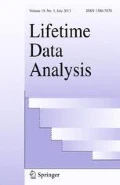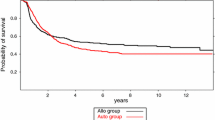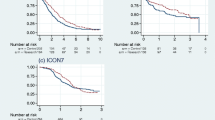Abstract
Medical research frequently involves comparing an event time of interest between treatment groups. Rather than comparing the entire survival or cumulative incidence curves, it is sometimes preferable to evaluate these probabilities at a fixed point in time. Performing a covariate adjusted analysis can improve efficiency, even in randomized clinical trials, but no currently available group sequential test for fixed point analysis provides this adjustment. This paper introduces covariate adjusted group sequential pointwise comparisons of survival and cumulative incidence probabilities. Their test statistics have an asymptotic distribution with independent increments, permitting use of common stopping boundary specification methods. These tests are demonstrated through a redesign of BMT CTN 0402, a clinical trial that evaluated a prophylactic treatment for adverse outcomes following blood and marrow transplantation. A simulation study demonstrates that these tests maintain the type I error rate and power at nominal levels under a variety of settings involving influential covariates.






Similar content being viewed by others
References
Andersen P, Borgan O, Gill R, Keiding N (1993) Statistical models based on counting processes. Springer, Berlin
Bilias Y, Gu M, Ying Z (1997) Towards a general asymptotic theory for Cox model with staggered entry. Ann Stat 25(2):662–682
Ciolino JD, Martin R, Zhao W, Jauch EC, Hill MD, Palesch YY (2014) Continuous covariate imbalance and conditional power for clinical trial interim analyses. Contemp Clin Trials 38(1):9–18
Ciolino JD, Martin RH, Zhao W, Hill MD, Jauch EC, Palesch YY (2015) Measuring continuous baseline covariate imbalances in clinical trial data. Stat Methods Med Res 24(2):255–272
Cox D (1972) Regression and life tables (with discussion). J R Stat Soc Ser B 34(2):187–220
Cutler C, Logan BR, Nakamura R, Johnston L, Choi SW, Porter DL, Hogan WJ, Pasquini MC, MacMillan ML, Wingard JR, Waller EK, Grupp SA, McCarthy PL, Wu J, Hu Z, Carter SL, Horowitz MM, Antin JH (2012) Tacrolimus/sirolimus vs. tacrolimus/methotrexate for graft-vs.-host disease prophylaxis after HLA-matched, related donor hematopoietic stem cell transplantation: results of Blood and Marrow Transplant Clinical Trials Network Trial 0402. Blood 120(21):739–739
Fine JP, Gray RJ (1999) A proportional hazards model for the subdistribution of a competing risk. J Am Stat Assoc 94(446):496–509
Gail MH, Wieand S, Piantadosi S (1984) Biased estimates of treatment effect in randomized experiments with nonlinear regressions and omitted covariates. Biometrika 71(3):431–444
Gray RJ (1988) A class of k-sample tests for comparing the cumulative incidence of a competing risk. Ann Stat 16(3):1141–1154
Gu MG, Lai TL (1991) Weak convergence of time-sequential censored rank statistics with applications to sequential testing in clinical trials. Ann Stat 19(3):1403–1433
Hauck WW, Anderson S, Marcus SM (1998) Should we adjust for covariates in nonlinear regression analyses of randomized trials? Control Clin Trials 19(3):249–256
He P (2014) Bias reduction by using covariate-adjusted censoring weights for survival and competing risks data. Doctoral Dissertation, Medical College of Wisconsin
Jennison C, Turnbull BW (1999) Group sequential methods with applications to clinical trials. CRC Press, Boca Raton
Klein JP, Andersen PK (2005) Regression modeling of competing risks data based on pseudovalues of the cumulative incidence function. Biometrics 61(1):223–229
Kosorok M (2008) Introduction to empirical processes and semiparametric inference. Springer, New York
Lin D, Shen L, Ying Z, Breslow N (1996) Group sequential designs for monitoring survival probabilities. Biometrics 52(3):1033–1041
Logan BR, Zhang MJ (2013) The use of group sequential designs with common competing risks tests. Stat Med 32(6):899–913
Logan BR, Zhang M, Klein JP (2011) Marginal models for clustered time-to-event data with competing risks using pseudovalues. Biometrics 67(1):1–7
Martens MJ, Logan BR (2018) A group sequential test for treatment effect based on the Fine-Gray model. Biometrics 74(3):1006–1013
Peto R, Pike M, Armitage P, Breslow N, Cox D, Howard SV, Mantel N, McPherson K, Peto J, Smith P (1976) Design and analysis of randomized clinical trials requiring prolonged observation of each patient. i. Introduction and design. Br J Cancer 34(6):585
Pocock SJ, Assmann SE, Enos LE, Kasten LE (2002) Subgroup analysis, covariate adjustment and baseline comparisons in clinical trial reporting: current practice and problems. Stat Med 21(19):2917–2930
Pollard D (1990) Empirical processes: theory and applications. In: NSF-CBMS regional conference series in probability and statistics. Institute of Mathematical Statistics, Hayward, California; American Statistical Association, Alexandria, Virginia, pp. 1–86
Robinson LD, Jewell NP (1991) Some surprising results about covariate adjustment in logistic regression models. Int Stat Rev 59(2):227–240
Scheike TH, Zhang MJ, Gerds TA (2008) Predicting cumulative incidence probability by direct binomial regression. Biometrika 95(1):205–220
Zhang M, Tsiatis AA, Davidian M (2008) Improving efficiency of inferences in randomized clinical trials using auxiliary covariates. Biometrics 64(3):707–715
Zhang X, Loberiza FR, Klein JP, Zhang MJ (2007) A SAS macro for estimation of direct adjusted survival curves based on a stratified Cox regression model. Comput Methods Programs Biomed 88(2):95–101
Acknowledgements
Support for this study was provided by Grant #F31HL134317 by the National Heart, Lung, and Blood Institute of the National Institutes of Health. Support for the BMT CTN 0402 trial was provided by Grant #U10HL069294 to the Blood and Marrow Transplant Clinical Trials Network from the National Heart, Lung, and Blood Institute and the National Cancer Institute, along with contributions by Wyeth Pharmaceuticals Inc. The authors thank the Blood and Marrow Transplant Clinical Trials Network for permitting use of the 0402 trial data. The content is solely the responsibility of the authors and does not necessarily represent the official views of the above mentioned parties.
Author information
Authors and Affiliations
Corresponding author
Additional information
Publisher's Note
Springer Nature remains neutral with regard to jurisdictional claims in published maps and institutional affiliations.
Electronic supplementary material
Below is the link to the electronic supplementary material.
Rights and permissions
About this article
Cite this article
Martens, M.J., Logan, B.R. Group sequential tests for treatment effect on survival and cumulative incidence at a fixed time point. Lifetime Data Anal 26, 603–623 (2020). https://doi.org/10.1007/s10985-019-09491-z
Received:
Accepted:
Published:
Issue Date:
DOI: https://doi.org/10.1007/s10985-019-09491-z




